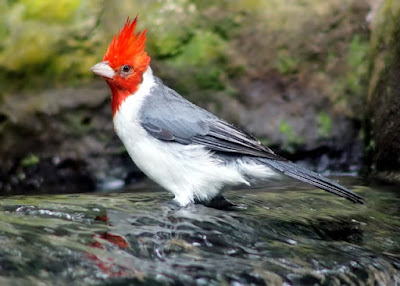Nature has a unique way of bestowing beauty on the world, and one of its most charming creations is the Cardinal. These vibrant red birds are more than just a pretty sight to see in our backyard; They have deep cultural, spiritual and ecological significance. In this article, we'll explore the cardinal's physical characteristics, symbolism, and its role in the natural world.
Physical characteristics
Cardinals are medium-sized birds native to North and South America. The northern cardinal (Cardinalis cardinalis) is perhaps the most famous, celebrated for its bright red feathers and contrasting black mask-like markings on its face. Female cardinals, on the other hand, have a more subdued appearance with grayish-brown feathers and red accents.
Both male and female cardinals have a distinctive crest on their heads, which they can raise and lower as they communicate. Cardinals have strong, conical bills that are suitable for cracking open seeds, which is their primary food source. Their strong beaks also make them efficient insect hunters, especially during the breeding season when protein-rich insects are essential to feed their young.
Symbolism and cultural significance
Cardinals have been symbols in various cultures and belief systems throughout history. Their attractive red feathers are often associated with vitality, love, and passion. In Christianity, the bright red feathers of the cardinal represent the blood of Jesus Christ, a symbol of spiritual awakening and renewal. In fact, the word "cardinal" is derived from the Latin word "cardo", meaning hinge or turning point, emphasizing their spiritual importance.
In Native American traditions, cardinals are considered messengers from the spirit world, bringing important messages and guidance to those who encounter them. His presence is often seen as a reminder to keep focused on your goals and dreams.
The cardinal has also played a prominent role in various folk beliefs. In some cultures, seeing a cardinal is believed to bring good luck or even a visit from a deceased loved one. Others see cardinals as symbols of hope and resilience, especially during difficult times.
Ecological importance
Beyond their symbolic importance, cardinals play an important role in their ecosystems. They are omnivorous birds, meaning that their diet is diverse including seeds, fruits, insects and even small amphibians. This dietary versatility makes them important players in controlling insect populations, especially during the breeding season when they feed a protein-rich diet of insects and spiders to their young.
Cardinals are also known for their distinctive songs, which serve both territorial and courtship purposes. Their melodious calls can be heard all year round, but they become particularly active during the breeding season when males sing to establish and defend their territory.
Their nests are usually built in dense bushes or trees, providing shelter for their eggs and young chicks. Cardinals are known to be highly protective parents, and both males and females take turns incubating the eggs and feeding their offspring.
The Cardinal, with his striking appearance and rich symbolism, reminds of the complex relationship between nature, culture and spirituality. Its vibrant red plumage, distinctive song and ecological role make it an important part of the natural world. Whether you encounter a cardinal in your backyard or see him in a religious or cultural context, take a moment to appreciate the beauty and importance of this remarkable bird – a creature that brings both joy and meaning to our lives.
Here are some interesting facts about Cardinals:
- Distinctive Appearance: Male cardinals are known for their brilliant red feathers, which are especially vibrant during breeding season. They have striking black masks around their eyes and a crest on their heads. Female cardinals have a more subdued appearance, with grayish-brown feathers and reddish accents.
- Year-Round Residents: Cardinals are non-migratory birds, meaning they stay in their area all year round. They are a common sight in North and South America, with the northern cardinal being the most recognized species.
- Omnivorous Diet: Cardinals have a varied diet. While they primarily eat seeds, including sunflower seeds, they also consume fruits, insects, and small invertebrates. During the breeding season, they rely more on insects to provide protein to their growing chicks.
- Territorial Birds: Male cardinals are highly territorial and will defend their territory from other males. They use their distinctive songs to establish and maintain the boundaries of their territory.
- Monogamous Pairing: Cardinals are known to form monogamous pairings that often last for several breeding seasons. Married pairs are often seen searching for food together.
- Year-round singers: Unlike some bird species that only sing during the breeding season, cardinals are known to sing year-round. Their songs serve a variety of purposes, including communication between mated pairs and territorial defense.
- Frequent nesters: Cardinals are prolific nesters, often raising several litters in a single breeding season. They build cup-shaped nests in dense bushes or trees, providing a safe place for their eggs and chicks.
- Vigorously Protective Parents: Both male and female cardinals take an active role in raising their young. They are known to be devoted and protective parents, with males helping to incubate the eggs and feed the young.
- Vocal Mimicry: Cardinals are skilled vocal imitators and can imitate the calls of other bird species. This ability helps them communicate with a wide variety of birds and may be a useful survival strategy.
- State Bird: The northern cardinal is the state bird of several US states, including Illinois, Indiana, Kentucky, North Carolina, Ohio, Virginia, and West Virginia. Its vibrant red coat and year-round presence make it a popular and recognizable symbol.
- Symbolism: Cardinals have deep cultural and religious symbolism. In Christianity, the red color of the cardinal is associated with spiritual awakening and renewal, while in Native American traditions, they are seen as messengers from the spiritual world, often bringing important messages or guidance.
- Nocturnal Hunting: Cardinals are known to occasionally eat snails, slugs, and spiders, making them nocturnal hunters as well. These additional food sources supplement their diet.




Comments
Post a Comment